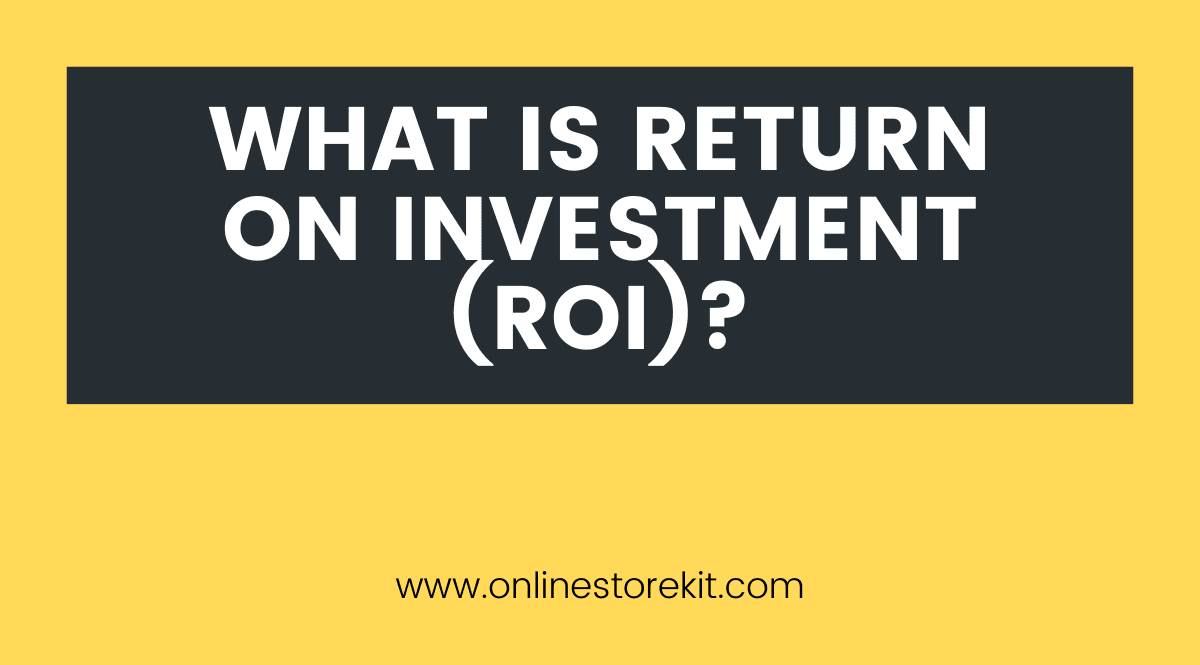It has been established that the fundamental measure for assessing financial performance is return on investment (ROI).
As such, it is important to understand what ROI is and how it can be used as an indicator of success.
This article provides a comprehensive guide to ROI, including its definition, calculation methods, benefits, common metrics, challenges, and strategies for optimization.
Summary
Hide- ROI is a measure of the profitability or efficiency of an investment.
- It helps businesses make informed investment decisions and prioritize investments.
- ROI calculations consider the initial cost, net profit, and the time value of money.
- Conducting a benefits analysis aids in determining the potential profitability of investments and identifying areas for improvement or cost savings.
What is Return on Investment (ROI)?
Return on Investment (ROI) is a measure of the profitability or efficiency of an investment.
It is used to evaluate various investments in order to determine which will yield the highest return and best cost benefit ratio.
This metric takes into account the time value of money, which states that a dollar today is worth more than a dollar in the future due to inflation and other factors.
ROI provides investors with an easy way to compare different investments and decide which is most likely to provide favorable returns.
The calculation for ROI can vary depending on the type of investment being evaluated, but it generally involves subtracting the initial cost from net profit or gain, then dividing this number by the initial cost.
The result is expressed as a percentage, representing how much profit was made relative to the initial investment amount.
A higher ROI usually indicates better performance than lower returns; however, it should also be weighed against risk factors when making any final decisions about where to invest funds.
Overall, ROI can be used as an effective tool for evaluating potential investments and optimizing portfolios for maximum return potential over time.
As such, it serves as an important factor in helping investors make informed decisions when allocating their resources into various markets and asset classes.
Calculating ROI
Return on Investment (ROI) is a key metric used to measure the profitability of an investment.
It is calculated using a formula that considers both its costs and benefits, enabling investors to compare various investments and make decisions accordingly.
A benefits analysis can be used to determine the value of the potential returns from an investment, allowing for more accurate calculations of ROI.
Formula Components
The components of the return on investment formula include an analysis of investment costs and returns.
This entails calculating the initial outlay, accounting for any transaction fees associated with the venture, and projecting potential income or gains.
Additionally, assessing investment risks is essential in order to determine if returns are sufficient enough to justify taking them.
Risk assessment should take into account factors such as volatility, liquidity, and other external market forces.
Benefits Analysis
Conducting a benefits analysis is an important step in the return on investment process.
It helps to determine whether the potential rewards outweigh any associated risks.
A benefits analysis involves assessing the overall cost benefit and time value of a specific project or venture.
This may involve evaluating both tangible and intangible elements such as initial costs, expected gains, projected timeline for returns, and possible risks.
A thorough benefits analysis should provide detailed information about all relevant factors.
This allows decision makers to make informed decisions based on their individual objectives.
In addition to providing insight into the potential profitability of investments, benefits analysis can also be used to identify areas for improvement or cost savings.
Benefits of Calculating ROI
Calculating ROI can provide numerous benefits, such as allowing businesses to make informed decisions about potential investments.
Risk mitigation and cost savings are two of the primary advantages associated with taking the time to calculate a return on investment.
By understanding how much an investment may yield, organizations can make more informed decisions when it comes to allocating resources and capital.
| Benefit | Explanation | Example |
|---|---|---|
| Risk Mitigation | Calculating ROI helps identify areas of risk that should be avoided or minimized when investing in projects or initiatives. This allows businesses to make better-informed choices, reducing their exposure to risk. | An organization evaluates a project’s expected return compared with its potential risks before deciding whether or not it is worth investing in. |
| Cost Savings | By calculating ROI, businesses can determine if the expected returns justify the necessary costs for a particular initiative or project. This helps business prioritize investments and reduce wasteful spending on unnecessary projects. | A company uses ROI calculations to decide which new products or services will bring in the most revenue while minimizing cost expenditures. |
| Increased Efficiency & Profits | When used correctly, calculating ROI enables companies to maximize efficiency and increase profits by making wise decisions about where money is invested and what actions should be taken next based on past performance of similar projects. | An enterprise calculates its average ROI over multiple years and uses this information as a benchmark for future decision-making; ensuring they allocate resources efficiently in order to maximize profits over time. |
Common ROI Metrics
When calculating the return on investment (ROI), there are a number of different metrics that can be used to measure success. Common metrics include cost benefit, operational efficiency, and profitability.
Cost benefit analysis is a comprehensive evaluation of all costs associated with an investment versus its potential benefits. It helps to identify if resources will be utilized efficiently in order to achieve desired outcomes.
Operational efficiency examines how well investments are managed over time and if they provide the expected returns.
Lastly, profitability measures whether or not the investment has generated more money than was initially spent.
These metrics provide insight into whether or not an investment is worth making, and by understanding them it becomes easier to make informed decisions about future investments.
However, calculating ROI does come with certain challenges which must be addressed in order for accurate results to be obtained. This will be discussed in subsequent sections of this guide.
Challenges of Calculating ROI
Accurately calculating the return on investment (ROI) can be a challenging task for many businesses. This is due to errors in data accuracy, difficulty in measuring tangible benefits, and uncertainty in forecasting outcomes.
It is important that businesses are aware of these challenges when considering ROI as an effective metric for decision-making.
Accuracy of Data
Ascertaining the accuracy of data is essential for effective return on investment (ROI) evaluations. In order to accurately interpret ROI results, organizations must first understand and trust their existing data sources.
Artificial intelligence (AI) and predictive analytics can help ensure that data is accurate before it is used to make decisions.
AI can be used to detect anomalies and errors in datasets, while predictive analytics can provide further insight into the reliability of the data.
Organizations should also consider external factors that may affect the accuracy of their data, such as changing market conditions or political climates.
By understanding how these elements may impact their ROI calculations, companies can better assess the reliability of their data and use it effectively when making decisions about investments.
Tangible Benefits
Measuring tangible benefits of investments can provide organizations with invaluable insight into the effectiveness of their decisions.
Cost cutting and customer driven initiatives are two key areas where tangible returns on investment can be monitored.
Companies should evaluate how cost reductions are impacting customer experience and product or service quality.
Additionally, a return on investment analysis should consider any changes in revenue that result from implementing such cost-saving measures.
Understanding these tangible benefits can help organizations better forecast uncertainty in the future as well as make more informed decisions about their investments.
By having a clear understanding of the impacts of cost cutting and customer driven initiatives, it is easier to anticipate potential risks or rewards when making strategic investments.
This transition sentence leads to the next section which examines forecasting uncertainty in return on investment calculations.
Forecasting Uncertainty
When forecasting return on investment (ROI), it is important to take into account the uncertainty of outcomes. Risk assessment is a key part of this process, as it helps identify potential problems and gauge the level of risk associated with each possible outcome.
Data accuracy is also essential for accurate ROI forecasting, as inaccurate data can lead to wrong projections and misinformed decisions.
A thorough analysis should be conducted to help ensure that any assumptions made are reasonable enough to accurately predict future results.
Additionally, consideration should be given to the impact that external events may have on ROI forecasting, such as changes in the market or economic conditions.
By taking all these factors into account, organizations can gain better insight into their expected returns and make more informed decisions about their investments.
Tips for Improving ROI
Implementing strategies to increase return on investment can be a powerful tool for businesses.
There are several measures companies can take to improve ROI, such as maximizing cost efficiency by ensuring resources are allocated in the most effective way possible.
This can involve reducing unnecessary expenses and streamlining operations.
Another strategy is improving processes and procedures to reduce labor costs. By identifying areas where tasks can be automated or streamlined, companies can save on labor expenses and increase productivity.
Utilizing data analytics is also important in identifying areas where more resources or new investments are needed.
By analyzing data and identifying trends, companies can make informed decisions about where to allocate resources for maximum returns.
Creating a culture of change that encourages innovation and experimentation is another way to increase ROI.
By fostering an environment that values new ideas and encourages employees to take calculated risks, businesses can uncover new opportunities for growth and improvement.
Strategies for Optimizing ROI
One of the most important strategies for optimizing return on investment (ROI) is conducting a cost benefit analysis.
This involves analyzing the costs associated with different marketing campaigns and determining which will yield the highest ROI.
Additionally, customer segmentation can be used to identify customer preferences and target specific groups that are more likely to generate a higher ROI.
By focusing on those customers who are more likely to make purchases, businesses can create campaigns that are tailored to their needs, resulting in greater ROI.
Furthermore, businesses should also consider ways of reducing their overall costs while still providing quality products or services.
This could include negotiating better deals with suppliers or streamlining operational processes in order to reduce unnecessary waste.
Conclusion: Return on Investment (ROI) Definition and Guide
ROI is a valuable tool and metric for measuring the success of an investment or activity.
It provides important information that can help guide decision-making and improve efficiency.
Still, it is not without its challenges, such as accurately measuring intangible values.
However, with proper planning, assessing risks and developing strategies to optimize ROI can provide a solid foundation for long-term success.
Ultimately, understanding ROI principles and calculating returns on investments are essential skills for any investor or business owner looking to maximize their return on investment.





